
Garden Futurist – Big Research on Gardening Trees with Drew Zwart
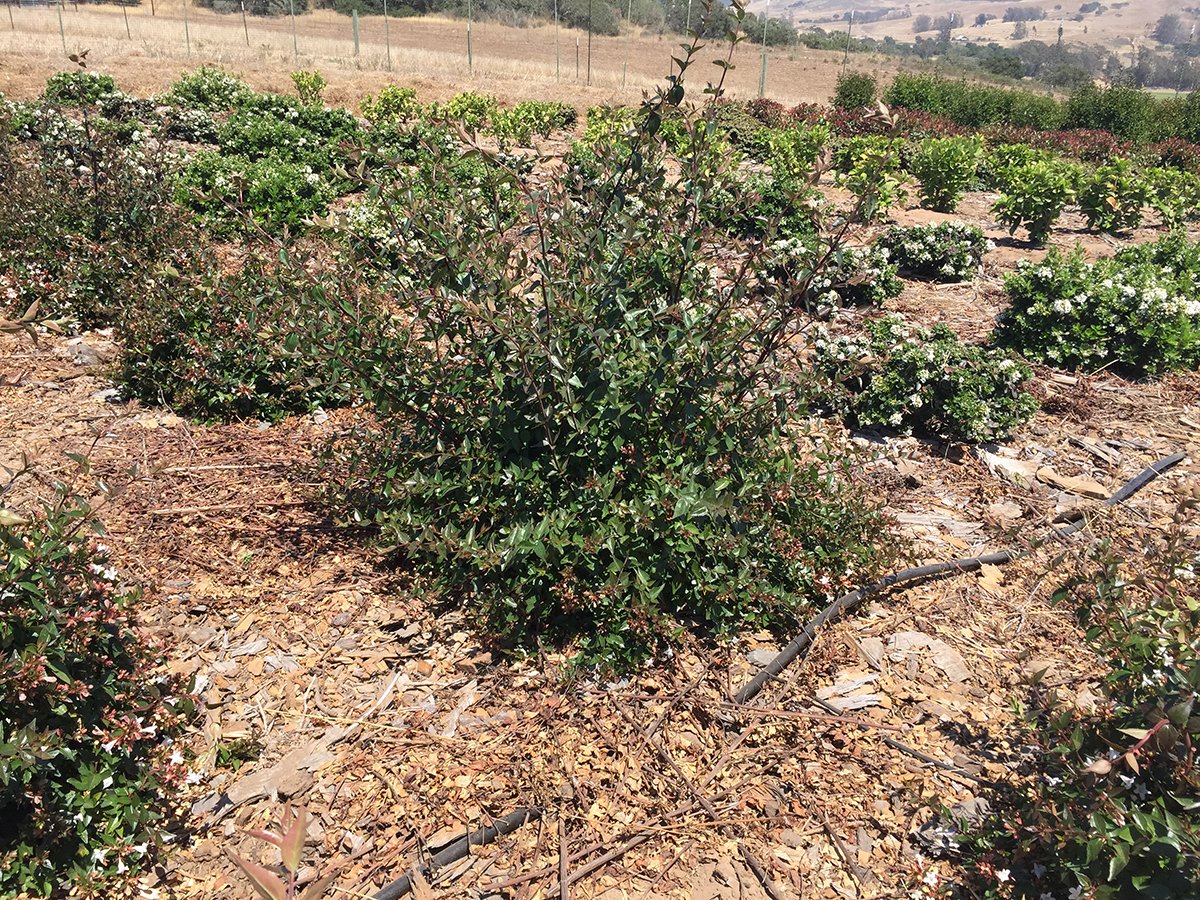
Contributor
- Topics: Garden Futurist, Sustainable Gardening
Fall 2021
Listen to the full Garden Futurist: Episode VIII podcast here.
While some areas of science get a lot of flashy language, Garden Futurist co-producers Sarah Beck and Adrienne St. Clair discover that what is happening in the tree research lab may also be described in explosive terms. Some of this large-scale research also informs low-tech takeaways that gardeners can use right away. Decisions we make in our home landscapes can have direct impacts to our carbon footprint.
Dr. Drew Zwart is a plant pathologist and physiologist at Bartlett Tree Experts. He works out of the Bartlett Tree Research Lab West in San Rafael, California. He explains that while trees that sequester carbon eventually decompose and re-release their carbon into the atmosphere, it’s the services they provide in life—such as shade and irrigation—that leave a net positive impact on the environment.
Studying trees in our gardens and public spaces can lead us to solutions for the difficulties that wild trees will face in coming years. City infrastructure absorbs and releases much more heat than surrounding areas, causing what’s called an urban heat island.
“Because of this heat island effect, the heat pressures on urban systems mirror what will be happening in wildlands in 50–100 years under climate change,” Portland Metro Botanist Adrienne St. Clair said.
While there’s no one miracle cure that prepares trees for environmental stress, Dr. Zwart discusses some of the micronutrient supplements and biostimulants that his lab uses to combat nutrient deficiency and drought stress. He also singles out endophytes—bacteria and fungi that live within root cells, rather than their rhizosphere cousins that live around roots—as integral to tree health. Trees thrive when gardeners make design choices that protect the microcosm in and around their root systems, such as clustering them together in mulch rings and reducing nutrient competition from turf.
Nutrient availability and root health may extend the lives of existing large trees, but gardeners must also consider future conditions when planting new tree species. In the same way that wilderness areas thrive on diversity, variety is the key to avoiding irreparable damage by any one disease or pest.
“The more options we give for responding to a changing climate, the more chances that ecosystem has of responding to those climate pressures,” St. Clair said.
During the following conversation, Beck and Zwart discuss ecosystem services, drought tolerance, lab techniques, tree disease, mulch rings, soil health, endophytes, and climate resilience. This interview has been edited and condensed to reflect the audio version on Garden Futurist.
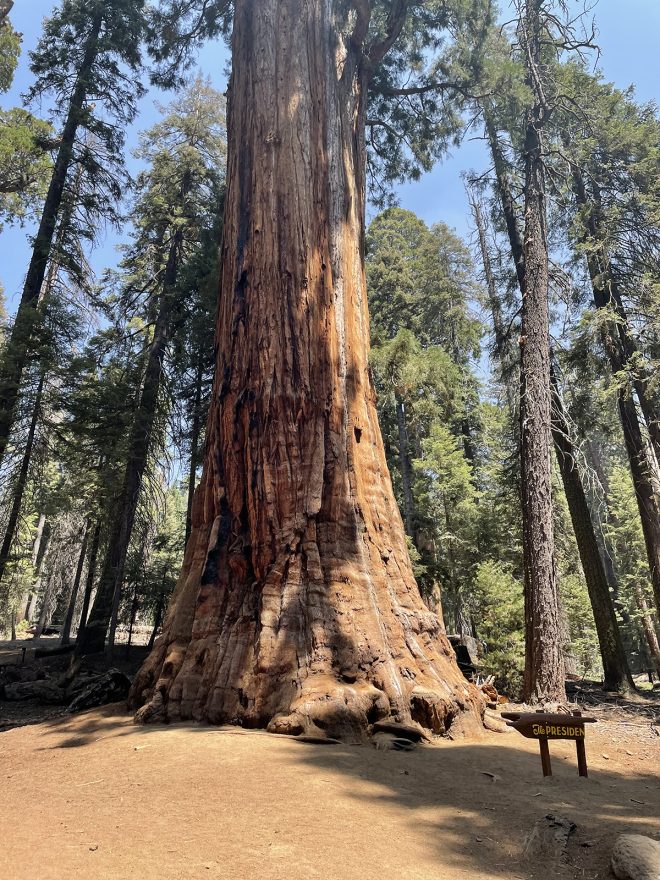
Sarah Beck: So I feel like there’s a lot of big trees on some people’s minds recently. I know I’m not the only one who has an emotional connection to very large trees. This year we saw in Sequoia National Park firefighters literally wrapping tinfoil, or it looks like it anyway, around General Sherman and some of those other named trees. They were installing sprinklers. And just maybe even the fact that humans feel the need to name large trees is revealing.
You said that the bigger the tree, the more ecosystem services. I’m wondering if you could explain what that really means?
Drew Zwart: Yeah, sure. So that statement’s mainly in relation to more of the urban or suburban landscapes or urban forest but kind of applies to all forest trees.
Trees are mainly made of carbon and that carbon comes from carbon dioxide in the atmosphere. So on a simple level, the bigger the tree, the more sequestered carbon that represents.
But in reality, that sequestration, that removal of carbon from the atmosphere is really on a decades or maybe centuries timeframe, but in the grand scheme of things, all trees are going to die. They’re all going to decompose. All that carbon is going to be rereleased in the atmosphere. So it’s really carbon neutral over the course of however many years that tree’s alive, then decomposes.
The real value in relation to climate and ecosystem services is in emissions that are avoided, not emissions that are sequestered. So whether that be trees that are shading a structure, a house, a business to avoid the need for excessive air conditioning, or perhaps acting as a wind block in colder climates to reduce the heating needs, rainfall interception and storm water mitigation, and then there’s habitat and food for wildlife. In all these things, bigger is better.
And there’s a number of different calculators that arborists and scientists use to establish a value of trees and one of the most heavily weighted factors is always size.
Sarah Beck: So when we talk about the role of big mature trees and how those big trees play into the health of our ecosystems and mitigating climate change, this also probably makes it worthwhile for us to put resources into helping them to survive climate impacts. I’m thinking about pressures like drought, something that’s on everyone’s minds in the West right now.
Drew Zwart: Yeah, I certainly think so. I mean, in areas especially of human habitation, trees are under a great deal of different stress factors. And a lot of it is human induced, whether it’s compaction or limited root zones or air pollution. But as I said, the bigger trees the better, and a lot of trees will never achieve the size necessary to really realize some of these benefits if they don’t have a little bit of help to get some of those stresses off the table.
We’ll never be able to control the weather. But we may be able to control some other stress factors to where the trees are able to deal with some of the stresses that we can’t control themselves.
Sarah Beck: You’ve done some interesting research on this. I know you collaborated with Oregon State University. Can you tell me about this, how you’ve found some ways through your research to improve the drought tolerance of these existing trees?
Drew Zwart: Yeah, there are a lot of different researchers looking at this issue from various angles. Some of the most important aspects being investigated are planting spaces, or planting pits as they’re commonly referred to, and what size or shape or volume is optimal. There’s also the whole world of plant breeding and coming up with plant species or species selection prior to planting, that’s going to be best suited both for the current and future environment.
But my specific research that I’m doing in collaboration with Dr. Lloyd Nackley at Oregon State University is more focused on soil amendments that we have the potential to use to improve an existing tree’s natural ability to tolerate stress.
So we’re looking at a few different, from simple to pretty complex, some of them are just simple micronutrient amendments that we know these micronutrients are physiologically related to drought-stress reactions. And so getting the soil up to optimal levels is going to help these plants to tolerate stress. Now, if they’re already at optimal levels, amending it’s not going to help as much, but a lot of soils are deficient in things like calcium and maybe potassium, which we know play a role in plant-water relations.
So that’s one. And then we’re also looking at what we’re loosely referring to as biostimulants, which I don’t know that there’s a good definition of biostimulants. There’s a lot of marketing material that will use that word. But these are probably more impactful on the microbial, the soil, and maybe even the in-plant microbial populations, and that can have a dramatic impact on plant health.
You know, if it weren’t for certain bacteria and fungi, plants would never have moved out of the marine environment and onto dry land in the first place. So they’re hugely impactful and a lot of different scientists are just starting to understand what some of these microbes are actually bringing to the table.
Sarah Beck: I’m really fascinated by these products, this idea of a biostimulant or micronutrients, I think sort of like smoothie, things you’d add to your smoothie or like a car additive where it’s like “miracle.”
I’m really curious. It sounds like these are having some promise. I’m sure it’s probably highly technical, but how do you actually see whether this is helping? You’ve got a mature tree and it’s almost like you’re giving it this little boost of medicine. How are you really able to watch that over time and see if it’s had an effect?
Drew Zwart: Well, to be fair, a lot of the research is done on small trees and then it’s extrapolated to big trees. So in that regard, there are some pretty simple ways to measure. It’s just growth rates and canopy density, and leaf area and photosynthetic capabilities.
So a lot of things are just simple measurements of size and growth rates. We’ll also measure things like stem water potential, which is basically a measure of how hard a tree needs to be pulling water to get it up to the canopy or how tightly it’s holding the water, which is a slightly destructive testing method.
Sarah Beck: I was just going to say, how in the world do you test drawing water?
Drew Zwart: Well, it’s actually a device, interestingly, the one that I use is called a pressure bomb, but it’s a device where you take a twig and you put it into a pressure chamber and basically the leaves are pulling the water towards them and you reverse that pressure and you can measure how hard those leaves are pulling by how much pressure it takes to make the water flow the other direction. And it’s a measure of how water-stressed or how much water those plants are really trying to pull.
And then on the really complex end of things, my colleagues and I do some measurements called chlorophyll fluorescence. Which is actually a direct measure of the health and efficiency of chlorophyll and the photosynthetic apparatus, which can tell you information that is not visible to the naked eye. So you can detect stress through chlorophyll fluorescence much more quickly than you would just waiting to see a plant wilt or a leaf scorch or something like that.
Sarah Beck: Wow. Kids at home have no idea that the tree scientists are doing some crazy stuff in the lab. I mean, my mind is blown. I’m really curious what you think the future of this kind of research could be. I hope I’m not taking this analogy too far, but are we going to get to this place where you can be really targeted, is it like targeted medicine for a tree?
Drew Zwart: I think it is, and in many regards we already have tree medicine for some plant health concerns, like disease and insect issues, and the bad word, pesticides, but there are other, again not very well defined, but there’s biostimulants that help to increase the plant’s natural ability to defend itself against disease or insect pests.
And I think that we’ll be able to dial it in to get some of those same concepts into environmental stresses and. And in all cases, with human medicine, keeping that analogy alive, any kind of prescription or recommendation without a diagnosis is malpractice, right? And so drought stress is drought stress, but there’s a lot of things that go into it.

So we really want to get to the underlying factor. Is this plant drought stressed because of the sheer lack of water? Or maybe there’s some root disease, maybe there’s soil compaction, maybe the soil isn’t holding moisture that you’re giving it, maybe there’s a nutrient deficiency. So until you really know what some of the underlying stress layers are, it’s hard to address them and it’s, you know, malpractice.
Sarah Beck: Wow. No, that makes perfect sense. It’s interesting, we’ve been talking about mature trees so far, but I think it’s clear that the mature trees that are alive today, at some point they’re not going to be with us anymore. And we really need to make sure that we’re looking at adaptation of what we’re planting.
I’m curious about how tree planting decisions and care will have an impact on climate resilience, looking into the future a little further.
Drew Zwart: Yeah, you know there’s a long list there related to that, the tree species selection. I don’t care what you’re talking about, whether it’s environmental stress or disease or insect problems, species selection is critical. And in relation to climate, we can’t just look at what’s suitable for our direct area now. We have to look at what the predictions are for the future, and of course there’s some variation there.
It’s not about what’s right now. Young trees, mid-maturity-level trees are pretty vigorous. It’s sort of like humans where I could do a lot of things when I was a teenager that I couldn’t get away with now. And it’s the same with trees. Trees will grow pretty robustly to a certain age and then they’ll start to be more impacted. So we got to think about where their stresses are going to come from in the future.
So for example, in our area around the bay, if you looked at a tree that’s adapted to the 100-year rainfall average, it really wouldn’t be very useful because we’re not anything comparable. If you look more at the 20-year rainfall average, it’s going to be much drier than that 100-year. And the next 20 is likely to be drier than that. So we have to look at plants that are adapted to what’s coming and not what’s past or even current.
And then diversity. Any sort of resilience, again, environmental stress or not, it’s all about diversity. We love to say, “Here’s a list of five trees. Let’s plant them all over the city,” but you get to a point where a new insect, a new disease is inevitable. It’s always happening. Our global trade is just the factor that we all have to deal with.
And so anytime you have more than 10 or 20% of a given species or genus of trees, you’re setting yourself up for a 10 or 20% loss of your urban canopy with the next pest that comes in. So really species diversity on up to family-level diversity of plantings.
That’s why a lot of research is done on creating climate-ready trees or climate-resilient trees, and making lists, and you get those lists. And then the nurseries, that’s all they grow. That’s all they stock. And then that’s all that the landscape architects can draw. That’s all that the landscapers can find. And now we have a lack of diversity and that leads to more likelihood of widespread canopy loss.
Sarah Beck: Sure. That makes me think back to those, those stories of those neighborhoods with the ash trees, with emerald ash borer coming in and every single tree gets down and you just have like complete devastation as a result.
Drew Zwart: Exactly. And before that it was Dutch elm disease and the American elm. A lot of the ashes were planted to replace elms and we didn’t learn our lesson, you know, and there’s always something on the horizon and you just got to diversify because there are some pests out there that will impact a wide swath of families or genera of trees, but it’s pretty rare. Most pathogens and insects are somewhat limited in their ability to attack one family or one genus of plants.
Sarah Beck: I’m curious if you think some of the avoidance of carbon emissions could have anything to do with how you design. You had mentioned where you’re placing the tree. I think in terms of sometimes when you see trees that are spread out across, say a lawn area. And Pacific Horticulture, we’re really into this “Life Not Lawn” idea. We are not super big on excess turf. So the idea that you’re, for instance, mowing circles around all of your trees. Is there some significance to that in terms of someone planning a landscape?
Drew Zwart: Oh, absolutely. I mean for both the reasons you mentioned and the lifespan of a tree, having turf grass growing right up to the base of a tree is an absolute no-no.
Turf grass is a competitor. It’s always going to get the water and nutrients before the tree roots do. Also, as you’re running those tightening circles around a tree, the likelihood of trunk damage from the string trimmer or the lawnmower increases. Every arborist out there, I hope, is always advocating for mulch rings. The bigger, the better.
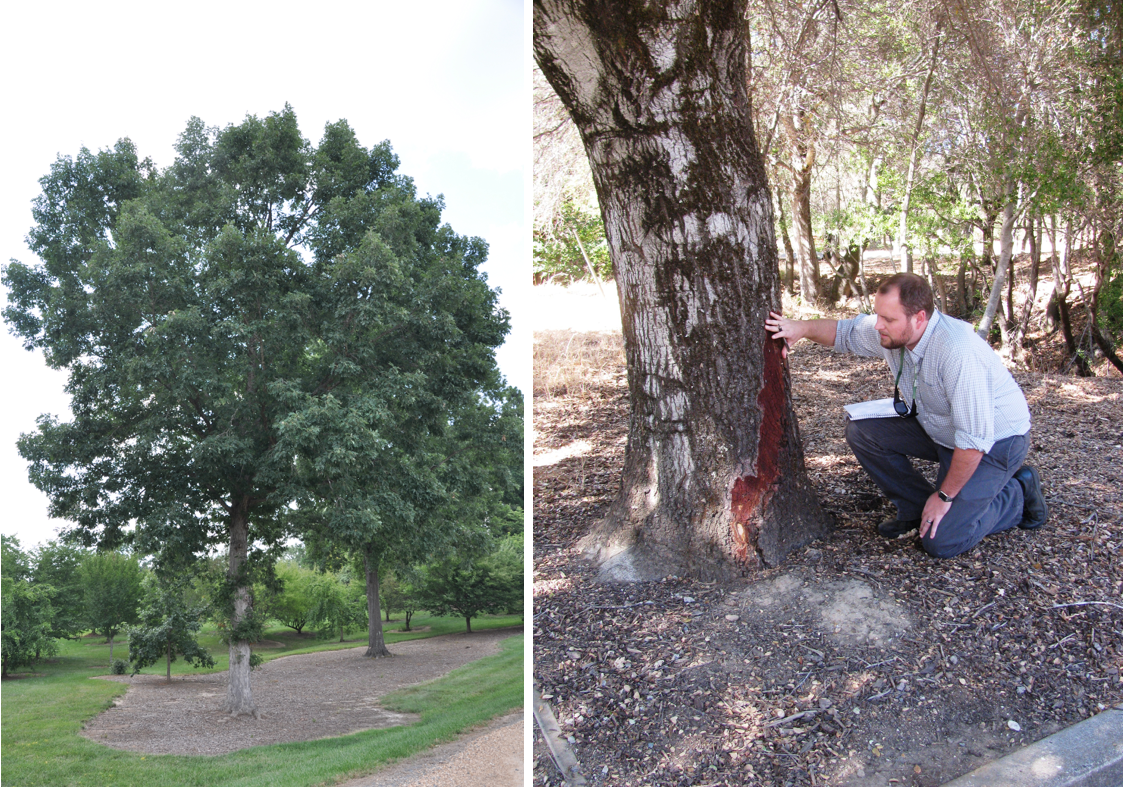
Right: Dr. Drew Zwart inspecting Sudden Oak Death treatment trial
There’s been some research done on the East Coast, at our laboratory facility in Charlotte and also elsewhere, where they looked at not just mulch rings around individual trees but planting in groups and having more of a mulch island where three or four root zones are connected all under mulch, rather than under turf. And the growth rates and the performance of trees is remarkably better, even compared to an individual mulch ring. So maybe even the same volume per tree, but just connected. Because trees talk, trees graft, trees share. And so having them together in an ideal soil condition is probably going to be helpful for all of them.
Sarah Beck: Oh, that’s such a wonderful addition. You also bring up something about just the scale of the reach of roots that I think a lot of people are not quite aware of.
Drew Zwart: Yeah. You know, roots for the most part go wherever there’s nutrients, water, and oxygen. There are structural roots that go pretty deep, but the roots that are really doing the bulk of the uptake work are going to be in the top foot or so of soil, and it all depends on your soil types.
So really looking at the volume and it’s more of a surface volume. We always talk about digging holes wider, not deeper, and there’s a number of reasons for that, but really knowing where the roots are, it’s basically as far as you can imagine them without hitting something. So wherever there’s a physical barrier or a compaction of soil barrier, that’s really where the roots are going to go.
And we always talk about maybe five to six feet from a mature tree’s trunk is a critical root zone. The drip line is another sort of demarcation. The edge of the canopy is where we see another increase in density of fine roots, but that’s not where they stop. And if you’re protecting a tree, protecting it to the drip line, to the edge of that canopy is a good rule of thumb, but there’s definitely going to be roots beyond that. So roots will go almost as far as, as they can in any given situation until they hit something that stops them.
Sarah Beck: So you’re almost saying you have to like picture yourself as a drone looking down on that tree and go, “Wow, how far did the expanse of the canopy go?” It’s beyond that that your roots are?
Drew Zwart: Yeah. And I mean, I’ve dug holes in my own yard and, and found significant-sized roots that were from two properties over and I’ve been surprised and I studied these kinds of things.
So it’s really, really interesting. Especially at the University of Washington many, many years ago in their experimental forest, they essentially used a firehose to erode a hillside and look at the network of roots. And it was incredible. I mean, more complex than any superhighway system you’re ever going to find. And they go much further and connect to even unrelated species. It’s a vast world that we just don’t know enough about yet because of it’s the nature of it being invisible to us most of the time.
Sarah Beck: Oh, my gosh. There was something similar at the United States Botanic Garden a few years back where they took these prairie plants and they, it was sort of similar to the bodies exhibit thing. They somehow managed to remove all the soil from these massively long root systems and display them, I think they used some fancy resin or something.
When you’re thinking about all of the research and all of the things you’re learning right now, what do you think may someday change the way we garden with trees? If we can say we garden with trees.
Drew Zwart: I think it’s endophytes. I did a little bit of dabbling in it when I was at the University of Washington and there’s incredible work being done, but I think a lot of people who even pay a little bit attention to trees, understand mycorhizzae, where there’s these fungi that associate with tree roots, plant roots in general, and help to explore the soil, mine the soil for resources in trade for carbohydrates from the tree.
But I think what goes overlooked and has gone overlooked for a long time is that there are purely internal microorganisms, bacteria, fungi that are not connected to roots and extending into the soil, but are pure cellular-level infections, if you will, non-pathogenic.
We are just starting to understand what some of these microorganisms are doing. One of my colleagues used to say that all higher organisms are really just a bag of bacteria and it’s true. When you think about human bodies, the number of bacterial cells to human cells is, is almost, I’ve seen numbers as high as 10:1, but it’s a big number.
It’s true with plants, too. So just as an example, I’ve seen some research where some grasses were being grown on highly saline soils and researchers thought to themselves, how could this plant possibly survive with this much salt in the soil? And upon really in-depth study, they found a particular fungus that was internal to these plants. Without that fungus, these plants could not survive on these saline soils. Take it a step further, they were actually able to introduce this fungus into agricultural crops and make them more tolerant of salinity and soils.
When I was at University of Washington, this group was working on rice being such a staple crop in much of the world, but they were able to create a more saline-resistant rice strain. Not that they were breeding the plant, but they were adding a microbe to it. And again, this is a quote from one of my old professors, but why mess around with genetically trying to alter one gene or another, when you could slip an entire genome in there and get all the benefits of what these bacteria have to offer or fungi?
And there’s viruses that do the same. We always think viruses in a negative light. but they can actually do some things with their sort of hijacking of the genetic system that’s beneficial in some cases.
Garden Futurist is a show about innovative thinkers contributing to a climate resilient future through the power of gardens. If you like Garden Futurist, please consider subscribing wherever you get your podcasts and leaving a review on Apple Podcasts.
Resources
See Bartlett Tree Experts for more research-backed services from Dr. Zwart and his colleagues.
New Agriculturalist. 2011. Fungus helps rice adapt to stress.
United States Botanic Garden. Exposed: The Secret Life of Roots
See also the Life Not Lawn series
Share:
Social Media
Garden Futurist Podcast
Most Popular
Videos
Topics
Related Posts

Ground Up Science for Greener Cities with Garden Futurist Dr. Alessandro Ossola
Spring 2023 Listen to the Podcast here. Alessandro Ossola is a scientist who gets very excited about the challenge of climate change allowing for an

Readying Urban Forests for Climate Realities with Garden Futurist Dr. Greg McPherson
Winter 2023 Listen to the Podcast here. “Going from the mow and blow to a more horticulturally knowledgeable approach to maintaining the landscape. And that

Welcome, Greywater, to the Garden
Summer 2022 Oh, summer: delightful warm air, tomatoes swelling on the vine, fragrant blooms on an evening stroll. When it’s warm and rainless, how is
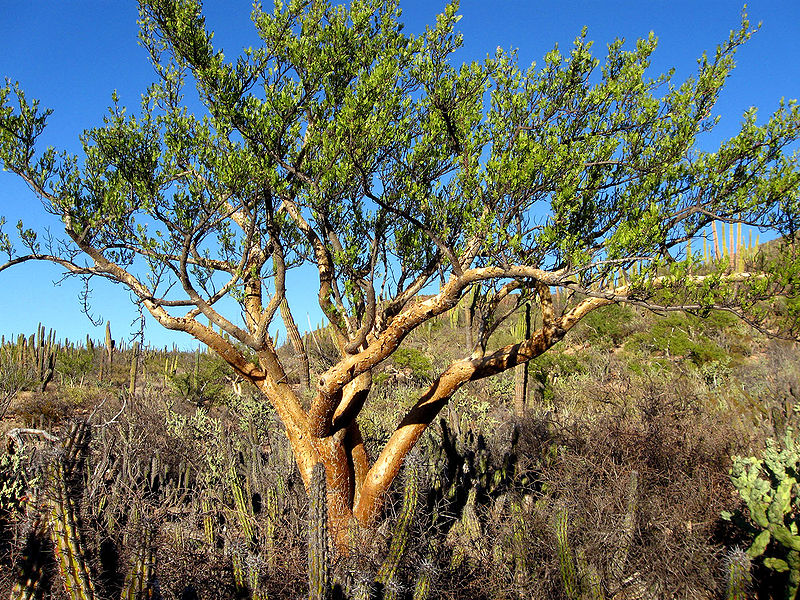
Big Tree-Data and Big-Tree Data with Garden Futurist Matt Ritter
Summer 2022 Listen to the full Garden Futurist: Episode XV podcast here. We are in an environmental crisis right now in many parts of California

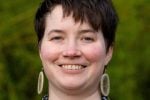







Responses